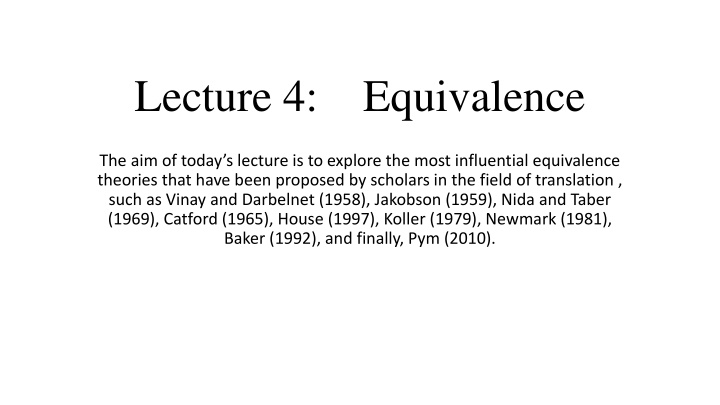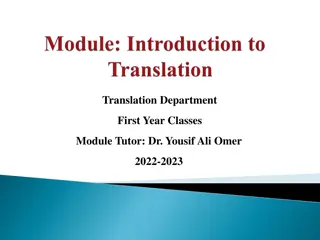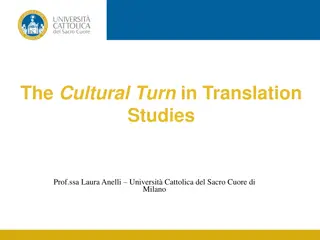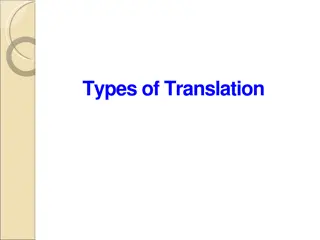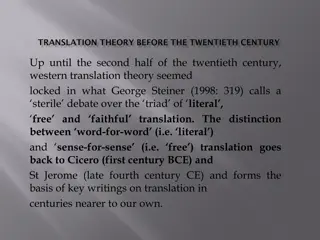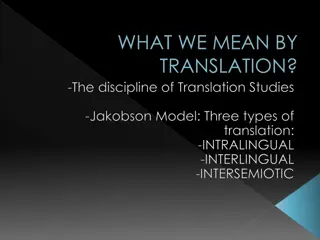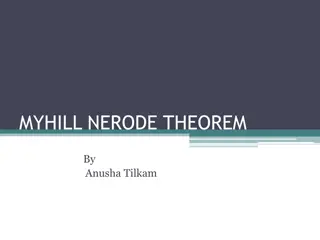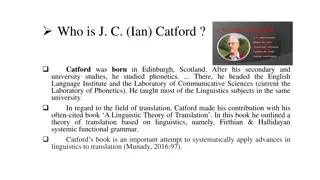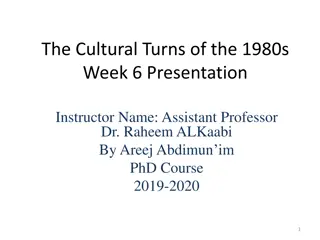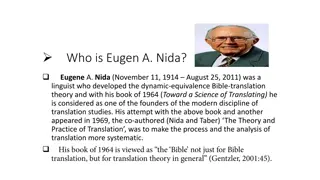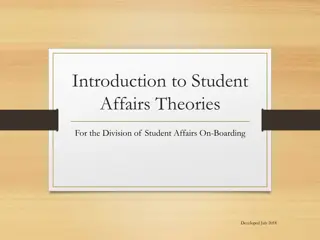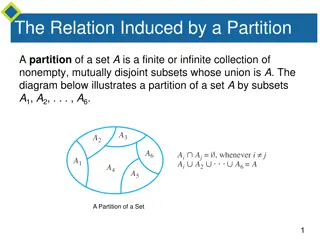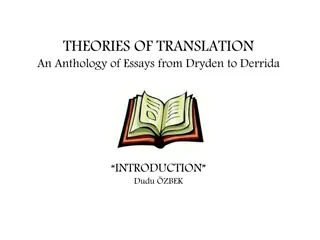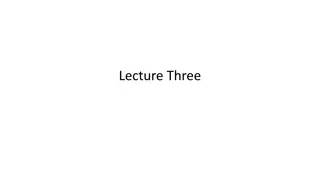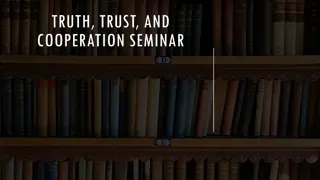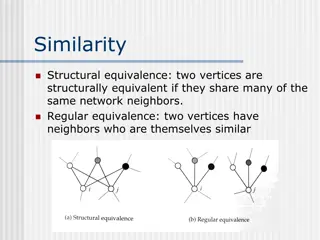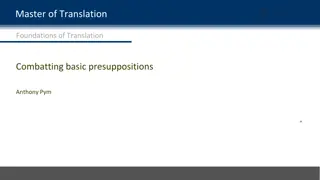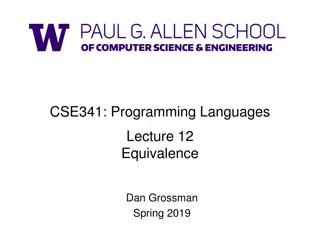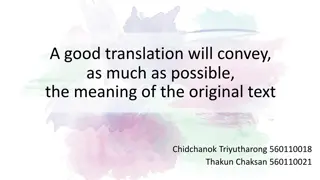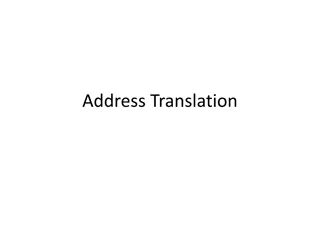Equivalence Theories in Translation Studies
Exploring influential equivalence theories by scholars such as Vinay and Darbelnet, Jakobson, Nida and Taber, Catford, House, Koller, Newmark, Baker, and Pym. Equivalence plays a central role in translation studies, but the concept remains debatable and controversial. The nature of equivalence raises philosophical questions about sameness, equality, and appropriateness, with scholars emphasizing viable translations over full equivalence. Different approaches in translation, such as formal, dynamic, functional, and cultural equivalence, are discussed.
Download Presentation

Please find below an Image/Link to download the presentation.
The content on the website is provided AS IS for your information and personal use only. It may not be sold, licensed, or shared on other websites without obtaining consent from the author.If you encounter any issues during the download, it is possible that the publisher has removed the file from their server.
You are allowed to download the files provided on this website for personal or commercial use, subject to the condition that they are used lawfully. All files are the property of their respective owners.
The content on the website is provided AS IS for your information and personal use only. It may not be sold, licensed, or shared on other websites without obtaining consent from the author.
E N D
Presentation Transcript
Lecture 4: Equivalence The aim of today s lecture is to explore the most influential equivalence theories that have been proposed by scholars in the field of translation , such as Vinay and Darbelnet (1958), Jakobson (1959), Nida and Taber (1969), Catford (1965), House (1997), Koller (1979), Newmark (1981), Baker (1992), and finally, Pym (2010).
Equivalence: Introductory Remarks Equivalence: Introductory Remarks The concept of equivalence can be said to hold a central position in translation studies. It has become an essential feature of translation theories in the 1960s and 1970s, and continued to be so even nowadays theories (see Munday, 2016); equivalence has been meant to indicate that source text (henceforth ST) and target text (henceforth TT) share some kind of sameness . The notion of equivalence is undoubtedly one of the most problematic and controversial areas in the field of translation theory. The term has caused, and it seems quite probable that it will continue to cause, heated debates among theorists/translators as to its nature, definition and applicability. This term has been analyzed, evaluated and extensively discussed from different points of view and has been approached from many different perspectives. It has been of particular concern to translation scholars since it has been inextricably linked with both definitional and practical aspects of translating. It has been a rather controversial one, causing many heated debates among theorists/translators as to its nature, definition and applicability.
Nature of Equivalence? Nature of Equivalence? The debatable nature of the concept lies in both the philosophical questions it implies, i.e. equality, sameness, identicality, exactness, appropriateness, comparison, viability, and the like, and in its problematic questions remain: what entities are/can be equivalent, how alike/similar/equal are they and how do we define 'alike/similar/equal and in which feature are they equivalent?, (Halverson cited in Sanchez-Ortiz 2000: 90). Bayar (2007: 214) states that equivalence is by definition an approximation of the ST, the identical duplication of which is indeed impossible in another. Consequently, translation scholars speak of viable translation rather than full-equivalent one.
Equivalence Defined: Sameness or Identicality? Equivalence is defined in varieties of ways, depending on the approach the theorist/translator adopts in the translation process; thus one may have types of equivalence that mark approaches or strategies the theorist/translator uses in translating a text cross-lingually: formal equivalence, dynamic, functional, optimal, directional, textual, pragmatic, cultural, and the like. Cambridge Learner s Dictionary (2001: 238) offers the following definition of the word equivalence : Something that has the same value, importance, size, or meaning as something else Vinay and Darbelnet (1995:342). view equivalence-oriented translation as a procedure which 'replicates the same situation as in the original, whilst using completely different wording House (1997: 26) comments that equivalence should not be envisaged as virtually the same thing since, linguistically speaking, it would be na ve to think of equivalence as a complete identity. Bassnett (2002: 36) is of a view that equivalence should not be approached as a search for sameness, since sameness cannot even exist between two TL versions of the same text, let alone between the SL and the TL versions . However, the question is as to the kind and degree of sameness which gives birth to different kinds of equivalence. The contentious nature of the concept lies in both the philosophical questions it implies, i.e. comparison and sameness, and in its problematic questions remain: what entities are/can be equivalent, how alike/similar/equal are they and how do we define 'alike/similar/equal', and in which feature are they equivalent? ( Halverson cited in Sanchez-Ortiz 2000: 90).
Types of Equivalence Types of Equivalence Farghal (1994, 2009, 2012) argues that all types of equivalence can be boiled down to a trichotomy, namely 'formal equivalence', 'functional equivalence' and 'ideational equivalence / (2009: 7, 2011: 7-8, 2012: 45-48). By and large, local strategies, such as cultural translation, paraphrasing, omission, addition, etc. lead to one of the three types of equivalence: formal vs. functional vs. ideational equivalence ( see Baker 1992: 72-78). Let s take the following English example: They are like two peas in a pod. Formal equivalence: focuses attention on the message in both form and content: Functional equivalence is obtained when special attention is paid to the function of the SL expression, independently of the form and its image conjured up in the mind of the SL reader, it is a functional equivalent Ideational equivalence is when the interfacing languages conceptualize the world experience linguistically in a similar way, giving rise to 'optimal equivalence' in which both formal and functional equivalents coincide (see Baker 1992: 72; Farghal 2012: 47).
Is Equivalence Achievable? Is Equivalence Achievable? Equivalence is by definition an approximation of the ST, the identical duplication of which is indeed impossible in another language. Jakobson (1959) stresses the fact that there can be no full equivalence between two words. He cites the example of cheese (similar to the Arabic word ) in English by saying that it is not identical to the Russian syr the concept of cottage cheese ( as the case with the Arabic type of cheese ) not being included in the latter. Gutt (1996) and, later, advocated by Farghal (2009: 7) holds that optimum translation is unattainable, hence the suggestion to replace the 'translation equivalence' with 'translation resemblance' in translation studies literature . Even-Zohar (1975: 43 quoted in Toury 1995: 56) argues that any translation is considered adequate (but not an exact translation of an ST) when it reflects in the target language the textual relationship of a source text with no breach of its own linguistic system .
Equivalence & Indeterminacy Equivalence & Indeterminacy The idea of indeterminacy was associated with the American Philosopher Quine where he claimed that the one set of data can be accounted for by more than one theory, and that there is no way to decide between the theories . Thus any ST is relatively open to more than one interpretation, consequently, leading to more than one TT. Quine posits a situation of 'radical translation', where there has been no previous contact between the cultures concerned (he immediately admits that real life provides no such situations). To exemplify his view, let s take the example of the class usually translated into Arabic as , however, if we check the realities of what constitutes that class we come out with varieties of types or forms of class: classes built of mud (no desks or chairs), averaged classes, technology supported classes, virtual classes (google class, etc.), or many others. The question now is: which class we are after or could stand as an exact translation of the English word or vice versa. Quine's analysis locates degrees of certainty for various kinds of propositions, but concludes that there can be no absolute determination of the translation. Similar to this example are the kinship terms like aunt or uncle and their Arabic equivalents or . Quine s theory of indeterminacy has a strong connection with the hermeneutic theory based on interpretation. Chau (1984) summarizes the hermeneutic approach in terms of a few basic tenets. Since there is no truly objective understanding of a text, no TT can fully represent its ST and all translations cannot but change the meaning of the ST. Chau claims that this general approach makes the translator at once humble and more responsible, taking part in the active creation of a translation rather than remaining a slave to illusions of necessary equivalence.
Equivalence & Quality Equivalence & Quality There is a strong connection between equivalence and quality. Translation equivalence and translation quality can take different shapes, depending on: the client s instructions & needs (as encoded in the translation brief), the nature of the text (literary, scientific, legal, media, religious, etc. the text type and function (informative, expressive, appellative, etc.) the person who evaluates the text (be it a translator, translation teacher, translation critic, assessor, commissioner and so on as well as the ideology dominates thereof). For example, given the different motivations for assessing the quality of a translation, a translation done for pedagogical (class) purposes and another conducted to be published will be assessed differently and with different criteria. Though most often than not based on objective criteria, any translation assessment involves a subjective element, and the assessor must keep it to the minimum. This means one cannot always guarantee the exact equivalence cross-lingually. What is considered a correct equivalent by one person might not be so by another. So, here, one would not hesitate to say that the appropriateness of equivalent would depend on the type of equivalent the translator tries to achieve along with other factors. The quality of the equivalent word, phrase, expression, message , or text would be influenced by other factors, for examples, the translator s level of competence, the source text difficulty or complexity, the purpose of the translation, the intended audience or readership, the publishing policy, and the translator s social, religious and ideological background. Professional issues such the translator s fees or time allocated to finish the translation could count also when it comes to evaluating the final product.
Jakobson s Theory of Equivalence Jakobson s Theory of Equivalence The structuralist Roman Jakobson (1959) maintains that there are three kinds of translation, that is, intralingual (rewording or paraphrasing within one language, such as icy and chilly, or or paraphrasing between two languages, such a Macdonalized market = ), and intersemiotic (rewording or paraphrasing between sign systems, like the case in gesturing where waving one s hand can be translated intersemiotically into hi ). Jakobson adopted a linguistic approach, arguing that translation is possible despite cultural or grammatical differences between SL and TL. He advocated the principle of equivalence in difference as the cardinal problem of language and the pivotal concern of linguistics. It means that the translator recodes and transmits a message received from another source; thus translation involves two equivalent messages from two different codes . ), interlingual (rewording
GOOD LUCK FOR YOU ALL GOOD LUCK FOR YOU ALL
